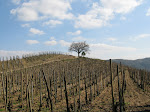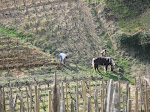
Sunday, December 21, 2008
Corton rouge announces it's coming out party

Thursday, December 18, 2008
A true kabinett

Monday, December 8, 2008
Gloomy mood at the Hospices de Beaune

Friday, November 28, 2008
Thanksgiving day at Chez Bobo




Wednesday, November 26, 2008
The Great Food and Wine Pairing Disaster
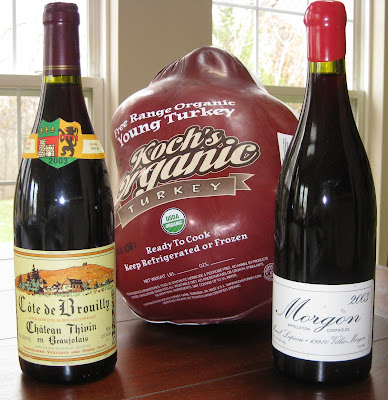
Monday, November 24, 2008
Sunday, November 16, 2008
Heymann-Lowenstein

Tuesday, November 4, 2008
Election Night

Saturday Night Football - 11/1

Sunday, October 26, 2008
Saturday Night Football - 10/25

The Bobo clan gathered for the big Penn State vs Ohio State showdown Saturday night. In an attempt to stay awake for the entire game, I selected a couple lighter alcohol wines for the evening. 2006 was a ripe warm vintage in the Wachau and the Franz Hirtzberger, Gruner Veltliner, Federspiel, Rotes Tor reflected those conditions. This vintage was richer and riper on the palate then usual for this bottling. Hirtzberger is located in Spitz at the western end of the Wachau, where the cool air gets trapped as it flows down the Wachau. This area tends to produce wines that are racier and more mineral driven than those from the rest of the Wachau. The main flavor I found in the 2006 was banana, which I often find in Gruner Veltliners from warm vintages (such as 2003). In contrast, the 2004 version of this wine was bright and lean. Hirtzberger is a very skilled producer and despite its richness, the wine was framed by an elegant texture. While I enjoyed this single vineyard cuvee, I find myself less enamored with Gruner Veltliners in general. The top producers in the Wachau usually charge the same amount for their Gruner Veltliners and Rieslings. Personally, I would rather consume a Riesling.
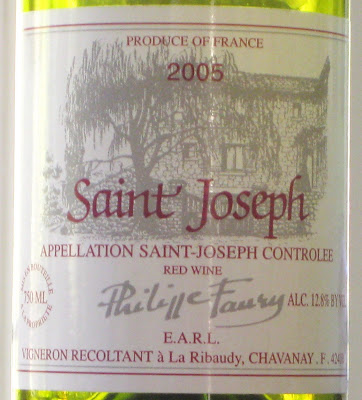
The next wine screamed northern rhone from the start. A good dose of black olive hit my nose as I sniffed the Phillipe Faury, Saint-Joseph, rouge, 2005. The wine was pure and elegant in the mouth. While traditionally styled, this wine was fruitier than the benchmark wines made by the great Raymond Trollat. It was a joy to drink a serious wine that weighed in at only 12.8% alcohol. I actually made it to the third quarter of the Hawaii game, which started at midnight!
Monday, October 13, 2008
Burgundy's great hidden treasure

"Is that really seven barrels of Montrachet?" I asked.
"Yes", our French associate replied. "The other 18 went to negociants."

 An interior view of the entrance to Domaine Thenard's cellar.
An interior view of the entrance to Domaine Thenard's cellar.The estate was founded in 1842 by Baron Paul Thenard, who married a local girl with the last name of Bordeaux-Montrieux. In subsequent years, control of the domaine passed through the female side to the Bordeaux-Montrieux descendants. Despite being virtually unknown in the U.S., Domaine Thenard has been famous in Burgundy for over a century due to one monumental purchase. Two large parcels of Le Montrachet, totaling 1.86 hectares, were acquired by Baron Paul Thenard in 1872. Only the Marquis de Laguiche, with their single parcel of 2.06 hectares (Puligny side), own more land in this fabled vineyard. By comparison, the third largest owner in Montrachet is Bouchard Pere et Fils with 0.89 hectares. In the 20th century, the grand cru vineyards Clos du Roi in Corton and Les Grands Echezeaux in Flagey were added to the portfolio. These vineyard acquisitions made Thenard one of the most important estates in Burgundy, yet the heart of the domaine remained in the humble village of Givry.

Baron Jean-Baptiste Bordeaux-Montrieux
Baron Jean-Bapstiste Bordeaux-Montrieux has been in charge of the winemaking at the domaine since the earily 1980's, but most of the wine was sold to Remoissenet while still in barrel. The bottles sold under the Remoissenet label were not held in high esteem, but the cuvees purchased from Thenard stood out. In his description of Remoissenet, Clive Coates (The Wines of Burgundy, University of California Press, Berkeley, 2008) wrote, "the firm distributes the wines of Domaine Baron Thenard and these - Le Montrachet, Corton Clos du Roi, Grands Echezeaux - are often the best." Maison Entienne Sauzet also purchases the Montrachet in must form from Thenard and this is the sole source for their much sought after cuvee. Today, the Baron holds back the top cuvees for the estate and controls every step of the winemaking. The wines bottled under the Domaine Thernard label are serious vin de garde (wines to keep). I was blown away by a 1976 Givry rouge tasted at the domaine during our visit. Amazingly, the wine was still very much alive.

The winemaking at Domaine Thenard is very tradtional and the wines have a firmness/rusticisty that reflect that style. The domaine's largest holding in Givry is in the premier cru Les Bois Cheveaux (7.66 ha), which tends to show slightly more power then the Givry premier cru Cellier Aux Moines (3.22 ha). Also in Givry is the premier cru Clos Saint-Pierre (2.12 ha). This vineyard, which is a monopole of the estate, produces the darkest colored and most ageworthy of the three Givry premier cru. In Pernand-Vergelesses, Thenard owns a piece of the finest vineyard in the village, Illes des Verglesses (0.85 ha). Right next door, on the hill of Corton, sits the domaine's prime parcel in the great Clos du Roi (0.9 ha ). The top section of Clos du Roi, where Thenard's vines are located, is considered superior to the lower portion of the vineyard and produces one of the more underated grand cru in Burgundy. Clive Coates considers Clos du Roi to be one of the very best vineyards in the Cote d'Or, on par with La Romanee Conti, La Tache, Chambertin and Le Musigny. Also included by Coates with those legendary names is Les Grands Echezeaux, of which Thenard is fortunate to own 0.54 hectares.
Three white wines are made at Domaine Thenard. The basic Givry blanc is fresh and bright. Far richer and more intense is the Chassagne-Montrachet, 1er Cru, Clos Saint-Jean (0.17 ha). The show stopper is, of course, the Le Montrachet (1.83 ha). In addition to owning a huge portion of this vineyard, the domaine is also blessed with old vines. The individual parcels were planted between 1931 and 1972. The resulting wine is deep in color and has an intense bouquet of white flowers and spicy oak. In the mouth, the wine is immense, but not heavy. A wave of minerals lurks in the background and keeps the wine from weighing down the palate. Thenard's Montrachet is truly a great wine.
Thursday, October 2, 2008
#@$%&%$! on Le Chambertin
Wednesday, September 24, 2008
Tomato Pie Night - 9/24
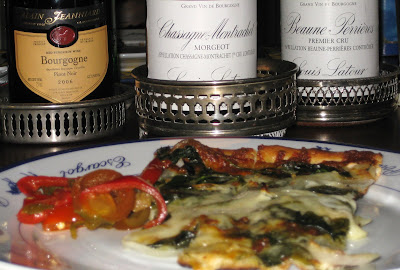
Saturday, September 20, 2008
Champange Sunday - 9/21


Friday, September 19, 2008
A intimate dinner with the Burghound, well....sort of

Wednesday, September 17, 2008
The six rules
1- Arrive late and leave early
It is a good idea to reduce the window of time that you are obligated to drink.
2- Drink only one half glass of Champagne
3- Stick to German Riesling and red Burgundy
The lower the alcohol, the better.
4- Consume a ton of water
I always feel like I should have a drink in my hand at these functions and rotating in several glasses of water is a smart move.
5- Never go out for the post party drink
6- Find someone to ride the train with you on the way home
Friday, September 12, 2008
Tomato Pie Night

The most recent installment of Tomato Pie Night was once again at Domaine Bobo and Burgundy was the main attraction. Our journey through the 2006 whites of Louis Latour continued with an excellent bottle of Batard-Montrachet. The wine was very rich and sexy. It was missing the minerals I find in the best examples from this vineyard, but was pretty tasty. Next up was Volnay, 1er Cru, Fremiets from Domaine Joseph Voillot. Jean Pierre-Charlot (winemaker at Voillot) crafts beautiful wines that are often fragrant and bright. Fremiets is usually the prettiest Volnay produced at this domaine and often shows well when young. The 2006 is a classic example of this wine was pretty yummy with the red pie. The disappointing part of the evening was the Rutgers football game that we had on in the background. Rutgers stadium is only a 30 minute drive north from our domaine, so we felt a profound sadness as North Carolina marched up and down the field. Rutgers may have lost in a blowout, but we washed away our disappointment with some terrific wines.

Tuesday, September 2, 2008
Champagne Sunday - 8/31


Friday, August 29, 2008
Tomato Pie Night

A good friend works for a company that distributes the wines of Louis Latour and he brought one of their wines over for dinner last night. The wine was a 2006 Louis Latour, Corton-Charlemagne, Grand Cru, which we drank while munching on white pie from the original Delorenzo's Tomato Pies in Trenton (Hudson Street). My expectations were not very high for the wine based on my past experiences with various Latour bottlings, but this bottle was really nice. The wine lacked the strong minerality that I expect in a Corton-Charlemagne, but it was full bodied and rich. I would not call this a great a example of what a Corton-Charlemagne should taste like, but it was a very good wine.
Saturday, August 23, 2008
Burgundy's mighty hill
Monday, August 18, 2008
Morey's hidden gem

Alain Jeanniard
2- Bourgogne, Passe Tout Grain, 2006 - (40 year old vines) This wine is very focused and bright on both the nose and palate. The long finish is dominate by red fruits and lively acidity.
3- Bourgogne, rouge, 2006 - This cuvee is sourced from vineyards in Morey-St.-Denis with yields of 35 hectoliters per hectare. The nose is full of elegant red fruits and the palate shows a beautiful earthiness that screams Morey.
4- Hautes-Cotes-de-Nuits, rouge, 2006 - (15 year old vines) Really nice texture. Rich, dark fruits coate the palate. Excellent.
5- Chambolle-Musigny, VV, 2006 - (80 year old vines) Very nice dark berry fruit on the nose. Meidum-full bodied with a long finish.
6- Gevrey-Chambertin, 2006 - (45 year old vines) Very expressive nose of red fruits. Full-bodied, but elegant on the palate. Beautiful wine.
7- Chambolle-Musigny, 1er Cru, Les Combottes, 2006 - Richer and riper on the palate. The wine is very concentrated, but also elegant. A classic Chambolle.
8- Morey-St.-Denis, 1er Cru, Les Chenevery, 2006 - Very soft and rich in the mouth. The long finish is full of earthy, red fruits.
9- Hautes-Cotes-de-Nuits, blanc, 2007 - (Barrel sample) Not as rich as 2006, but nicely balanced. Good mineral finish.
10-Bourgogne, rouge, 2007 - (barrel sample) Nice color. Deep and structured on the palate. Long and mineral. 10% of the stems were included.
11- Hautes-Cotes-de-Nuits, rouge, 2007 - (barrel sample) Awesome for the appellation. Very ripe and full. Really good.
12- Morey-St.-Denis, 2007 - (barrel sample) Very ripe and soft on the palate. Beautiful wine.
13- Gevery-Chambertin, 2007 - (barrel sample) 10 barrels were produced of this wine. More concentrated then the 2006. Really good potential.
14- Vosne Romanee, 2007 - (barrel sample) 10 barrels produced. The nose of red fruits and spice is classic Vosne Romanee. The flavors are long and silky. Beautiful.
15- Chambolle-Musigny, 1er Cru, Les Combottes, 2007 - (barrel sample) Very fresh and bright. Good weight.
16- Nuits-St.-Georges, 1er Cru, Les Damodes, 2007 - (barrel sample) This vineyard borders Vosne Romanee. Great concentration. Red fruits are combined on the palate with bright acidity. The finish is full of minerals. Very good.
17- Morey-St.-Denis, 1er Cru, Les Chenevery, 2007 - (barrel sample) Really good. Strong mineral quality to the wine. Beautifully balanced.
18- Pommard, 1er Cru, Les Saussilles, 2007 - (barrel sample) Very fresh nose. Full-bodied on the palate and slightly rustic on the finish. Really good potential.

Wednesday, August 13, 2008
Montrachet thought of the day
Dr. Jules Lavalle, Histoire et statistique de la vigne et des grands vins de la Cote-d'Or (1855)
Monday, August 11, 2008
Champagne Sunday - 8/10
For the main event, I opened a Lamy Pillot, Saint-Aubin, Pucelles, blanc. Pucelles is a lieu-dit near the village of Saint-Aubin. It was shocking how good this bottle was. I first became aware of this small producer based in Chassagne-Montrachet when I read that they bottle a Montrachet. Lamy Pillot barrel ferments all their wines and the Pucelles had a beautiful texture. Considering that this vineyard is not a premier cru, the wine's richness was surprising. The fruit was slightly tropical, but not over the top. I loved this wine.

Speaking of main events, I had been waiting all evening to see the 4 x 100 mens relay featuring Michael Phelps. At 11pm, an announcement flashed across the screen that the race would begin in 19 minutes. 'Thank goodness,' I thought sitting on the couch...................I woke up to see a volley ball flying across the screen. Half asleep, I stood up and turned the t.v. off. I walked upstairs and looked at the clock in the kitchen. 1:30am "The relay!" At that second I realized that I had fallen asleep and missed the biggest olympic event of the day. "Wait, I have a DVR," I thought in a moment of hope. Then I remembered that I had turned the t.v. off. The next morning, while making a soy latte, I heard a report on NPR detailing the race. The reporter concluded his segment by saying, "for those in the race and watching, it was an unforgettable olympic moment." Aarghh!!!!!!!!!!!!!!!!!!!!!!!!!!!!!!!!!!!!!!!!!!!!

Team USA celebrating their victory (2008 Getty Images, Inc.)
Sunday, August 10, 2008
A wine of Olympic proportion

Saturday, August 9, 2008
Puligny's forgotten family
Alain Chavy
Chavy-Martin, the offical title of Alain's estate, has the distinction of possessing the deepest cellar in Puligny. Only a handful of domaines in the village are fortunate enough to possess underground facilities due to the high water tabel. The barrels resting in Chavy's beautiful, arched cavern contain a terrific array of the finest premier cru vineyards found in the appellation. In addition to land in the prestigious plots Les Folatieres, Le Champ Gain and Les Pucelles, the domaine owns a precious parcel in Le Clavoillon. Les Pucelles and Le Cavoillon sit adjoined on the slope, but Chavy-Martin is one of only two cellars in Burgundy where you can taste them side by side. Domaine Leflaive owns the vast majority of the 5.59 hectare Le Clavoillon, but the Chavy brothers each claim a small portion, preventing it from being a monopole. The following wines were tasted from barrel while visiting the estate on March 19th, 2008:

Tuesday, August 5, 2008
My new nickname
Monday, August 4, 2008
Champagne Sunday - 8/3
Saturday, August 2, 2008
Clos de la Pucelle
 One of Burgundies outstanding 1er Cru vineyards, Les Pucelles borders the northern end of the grand cru Batard-Montrachet. Clos de la Pucelle is a lieu-dit that occupies the northwest corner of Les Pucelles. The Clos, which is a little over one hectare in size, is a monopole of the Puligny estate Jean Chartron.
One of Burgundies outstanding 1er Cru vineyards, Les Pucelles borders the northern end of the grand cru Batard-Montrachet. Clos de la Pucelle is a lieu-dit that occupies the northwest corner of Les Pucelles. The Clos, which is a little over one hectare in size, is a monopole of the Puligny estate Jean Chartron.Tuesday, July 29, 2008
The search for traditinoally made, elegant Cornas
Since hearing about Verset's retirement, a feeling of depression had been creeping over the Syrah portion of my brain (roughly 20%). Then, while reading John Livingstone-Learmonth's book The Wines of the Nothern Rhone, I came across a profile on a producer named Dumien-Serrette. Speaking about the owner of the domaine, Gilbert Serrette, Mr. Livingstone-Learmonth wrote that, "he speaks of his traditional methods with pride...vinification is traditional: full bunches, stalks included, are foot crushed, and then there is up to three weeks in neat concrete vats." Perhaps there was one last hold out in Cornas.

The village of Cornas seen from the Patou vineyard.
Back in March, before heading up to Burgundy, myself and two other business colleagues stopped by Cornas to visit Domaine Dumien-Serrette. Before leaving for France, my wife had warned me that I was not packing warm enough clothing for the trip. Sure enough, the spring jacket I brought along was near useless in the windy, 30 degree weather we encountered in the northern Rhone. After some chilly introductions at the front door of the family home in the center of town, we walked down a narrow road and entered the winery. The first piece of equipment to greet us was a giant wooden press. I had assumed that the press, like at most wineries, was there just for decoration. Gilbert explained, much to my surprise, that this was the current press for the winery. The estates entire production fit into one room, which was small. Used barrrels (2-15 years old) lined each wall, and the wine contained in each was a fragrant mix of black olives and dark fruits. In the mouth, these opaque wines were beautifully elegant with soft tannins.

The following notes were taken during our visit to the estate:
1- Cornas, 2007 (barrel sample) - Nice, deep color. Black fruits on the nose and in the mouth. Long, penetrating flavors.
2- Cornas, 2006 - Black color. Silky and long in the mouth. Excellent wine.
3- Cornas, 2005 - Black color. Elegant, pure nose. Black fruits in the mouth with big, firm tannins. A really nice wine with excellent concentration.
4- Cornas, 2004 - More aromatic then the preceeding wines. A little funky. The flavors are not as ripe and the wine is a little short on the finish, but still very good.

After years of selling in bulk to negociants such as Delas, Chapoutier and Jaboulet, Domaine Dumien-Serrette began to bottle wine in 1983. 1.6ha of the estate's 1.8ha is found in the Patou vineyard (the 0.2ha is located in Mazards), where the vines date back to the 1920's. Patou is very steep and Gilbert, who is in his 60's, cares for the vines by himself. The estate's total annual production from these two vineyards is about 500 cases, and Madame Serrette labels each bottle by hand. Gilbert learned the craft of winemaking from his father in-law and passed those lessons onto his son, Nicolas. After a stint in another industry, Nicolas returned to family business and today assists his father in the cellar. Nicolas, unlike many contemporaries, did not attend a wine school or receive any type of formal training. Beginning with the 2006 vintage, the junior Serrette's name will appear on the label and the estate will be known as Domaine Nicolas Serrette.
Serrette's Patou vineyard is further south then the more famous vinyards of the village. Patou sits fully exposed to the valley below and the winds rip through the old vines, which cling to the hard granite.

Steps are required to ascend the steep Patou vineyard.
We said goodbye to Monsieur Serrette and headed north to Saint Joseph. Before leaving for France, I had dreamed of descending on Cornas and finding Noel Verset's lost soul brother. Gilbert Serrette is certainly spiritually connected to Verset, but their wines are different. Serrette's wines are fruitier and not as earthy as the ones made by Verset, but they both show more elegance than those of Clape and Allemand. I am afraid to say it, but the ultra traditional style of wine made by Noel Verset is probably gone for good. Even the wine made by a traditionally minded producer like Serrette does not taste as old school as those bottled by Verset. That said, I am happy to report that I found a small vignernon tucked away in the Northern Rhone making traditionally styled, elegant Cornas.
Sunday, July 27, 2008
Champagne Sunday - 7/27
 Champagne Sunday started wtith some baked snails and, of course, Champagne. A bottle of NV Ployez-Jacquemart, Champagne, Brut, Marie Weiss was very good. Marie Weiss is a cuvee produced by Ployez-Jacquemart from purhcased fruit and is typical of the house style, which is elegant and reserved.
Champagne Sunday started wtith some baked snails and, of course, Champagne. A bottle of NV Ployez-Jacquemart, Champagne, Brut, Marie Weiss was very good. Marie Weiss is a cuvee produced by Ployez-Jacquemart from purhcased fruit and is typical of the house style, which is elegant and reserved.
With the main course of soft shell crabs we opened a 2004 Domaine Caillot, Bourgogne, blanc, Le Herbeux. The nose of the Bourgogne was dominated by aromas of toasted oak. On the palate, the oak was less obivous, but there was little in the way of fruit or minerality. To make matters worse, the wine disappeared half way through the mouth. I have not had any prior experience with this producer, but I was certaintly not impressed by this effort. The meal was saved by a 2006 Bachelet-Monnot, Bourgogne, blanc that was beautifully balanced. Sourced from several plots within Puligny-Montrachet, this Bourgogne revealed citrus fruits in the mouth and a fine minerality on the finish. Bachelet-Monnot is young producer that has made a great range of wines in 2006, which is only the second vintage for the domaine. One side note, the soft shell season is starting to wind down and the crabs are getting smaller.





